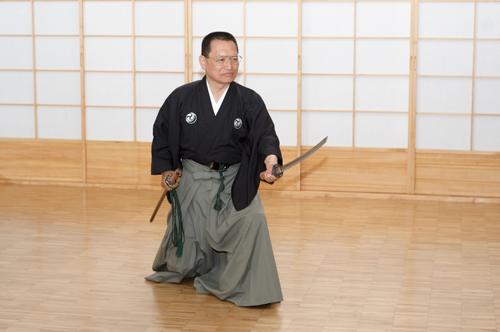Použití wakizashi levou rukou
Gyokushin Shinto Ryu má kořeny v Mugai Ryu Iaijutsu a Kenjutsu za použití wakizashi/kodachi (krátký meč) výhradně levou rukou.
Tento styl byl vytvořen Niina Gyokudo Toyoaki Sokem a je založen na Mugai Ryu a Shinto Ryu. Impulsem k vytvoření tohoto stylu byla jedna japonská dáma, která se chtěla učit Iai a Kenjutsu. Neměla však pravou rukou a tak to pro ní bylo do té doby než potkala Soke Niinu nemožné. Niina Gosoke o tom přemýšlel a poté vytvořil Gyokushin Shinto Ryu. Tato škola není unikátní záležitostí pouze v Japonsku, ale zároveň to znázorňuje hlavní myšlenku Mugai Ryu, že každý, bez rozdílu národnosti, víry, sociálního postavení a všeho dalšího má možnost se učit umění samurajů.
Samozřejmě, že tento styl není pouze pro lidi, kteří nemohou používat pravou ruku. Je to extrémně realistické a efektivní umění zahrnující 16 Iaido kat a 16 Kumitachi/kenjutsu kat. Dokonce je vyučováno i formou tameshigiri.
Samurajové se většinou učili používat katanu a wakizashi oběma rukama nebo pouze pravou rukou. Jediným stylem, vedle Gyokushin Shinto Ryu, který používá také levou ruku je Hyoho Niten Ichi Ryu – styl založený Miyamoto Musashim. V této škole je však pouze jako jakýsi „podpůrný prostředek“ v Nito Seiho, tedy v katách kde se bojuje dvěma meči. V Gyokushin Shinto Ryu je levá ruka používána stejným způsobem a ve stejné kvalitě jako obě ruce nebo pravá ruka s katanou. Toto otevírá kompletně nové spektrum možností pro všechny studenty Iaida, Kenjutsu nebo Battojutsu.
Způsoby použití jsou podobné jako u Niten Ichi Ryu při použití dvou mečů, ale jsou přidány aspekty Iai. Použití levé ruky s wakizashi může pro oponenta v boji znamenat značné překvapení. A to především proto, že se používá velmi atypických úhlů a os, které nemohou být provedeny při použití meče v pravé ruce. Je to také velmi cenná dovednost pokud Vám z nějakého důvodu neumožní situace bojovat pravou rukou. Dalším příkladem může být boj proti více oponentům, kteří Vás obklíčí. Katana může kontrolovat jednu skupinu oponentů a kodachi může kontrolovat skupinu druhou. Také je možné, pokud nemá samuraj dostatek času tasit katanu pravou rukou, může rychleji tasit wakizashi rukou levou.
Niina Gyokudo Toyoaki Soke
A jeho slova ohledně Gyokushin Shinto Ryu
„Počínaje s Iaido a včetně Jo, Tanjo, Jutte, Tanken a kusarigama jsem se snažil zprostředkovat výuku Budo otevřením dveří všem lidem bez ohledu na jejich rasu, národnost, vyznání, náboženství, pohlaví, věk nebo povolání. Stejně tak jsem chtěl umožnit trénovat bojové umění lidem se zdravotním postižením. Například lidé s postižením nohou mohou provádět Zagi (kata v sedu) a mám mnoho studentů, kteří se zdokonalují a trénují tímto způsobem.
Od dávných dob se však v bujutsu používá katana s dominancí pravé ruky. Pro lidi, kteří nemohou používat pravou ruku, není prohození levé ruky za pravou ruku řešením. Tento problém není pouze se Saya-biki (stažení pouzdra meče vzad) při tasení meče. Neschopnost používat v iaido obě ruce je zásadním problémem.
Proto jsem vytvořil systém Iai, který vyžaduje pouze použití levé ruky s kompletní absencí pravé ruky a který je založen na technikách Shinto Ryu a Mugai Ryu. Jméno, které jsem dal tomuto stylu a do kterého jsem „nalil“ mé znalosti a dovednosti se jmenuje „Gyokushin Shinto Ryu“ a to na základě mého bojového jména Gyokudo. Iai této školy používá pouze kodachi a obsahuje 3 základní (kihon) katy, 8 kata v sedu (Zagi), 8 kata ve stoje (tachi waza) a 16 kata s partnerem (kumitachi/kenjutsu). Tato škola obsahuje zároveň etiketu (Reiho) a pohyby těla, které lidé, pokud mají postiženou pravou ruku, vykonávají pouze levou rukou.
Protože základem tohoto nového stylu je koryu bujutsu a styly jako je Shinto Ryu a Mugai Ryu, které oba mají historii starou stovky let, nebude to žádné „tancování“. Samozřejmostí jsou předepsané technické dovednosti, udílení certifikátů kyu/dan, menkyo a dalších svitků stejně jako je tomu v Mugai Ryu.
Bylo by skvělé, kdyby lidé využili tuto myšlenku pro svůj trénink Iai a skrze jejich zdravotní postižení mohli zažívat genialitu a potěšení z Iai a kenjutsu“.
Toto bojové umění je vhodné pro:
- Osoby se sluchovým postižením, které mohou trénovat se zdravými lidmi bez větších problémů.
- Osoby s postižením nohou, které mohou trénovat stejně jako lidé s postižením kolen.
- Osoby s postižením levé ruky, které mohou plnohodnotně trénovat spolu s lidmi bez zdravotních problémů
